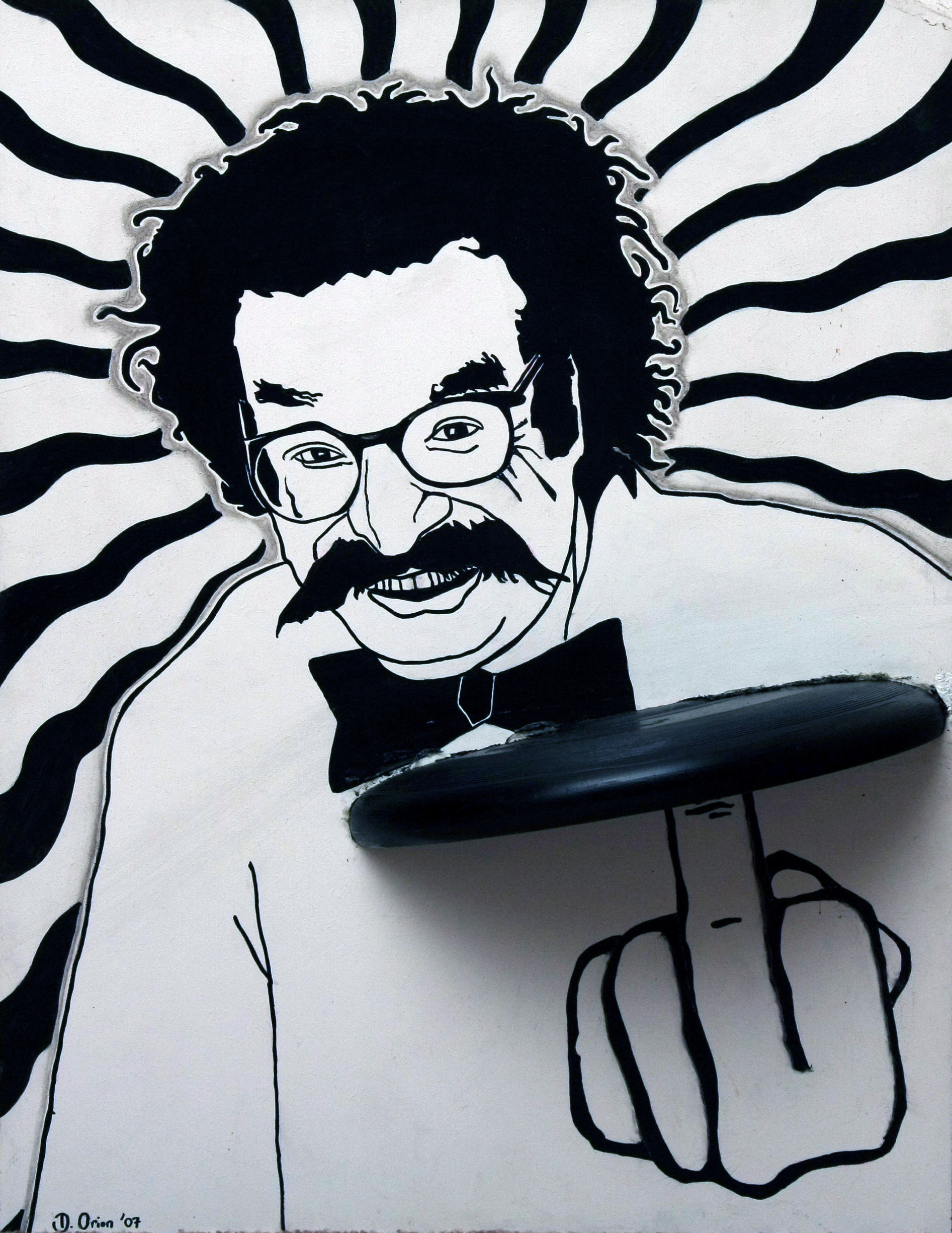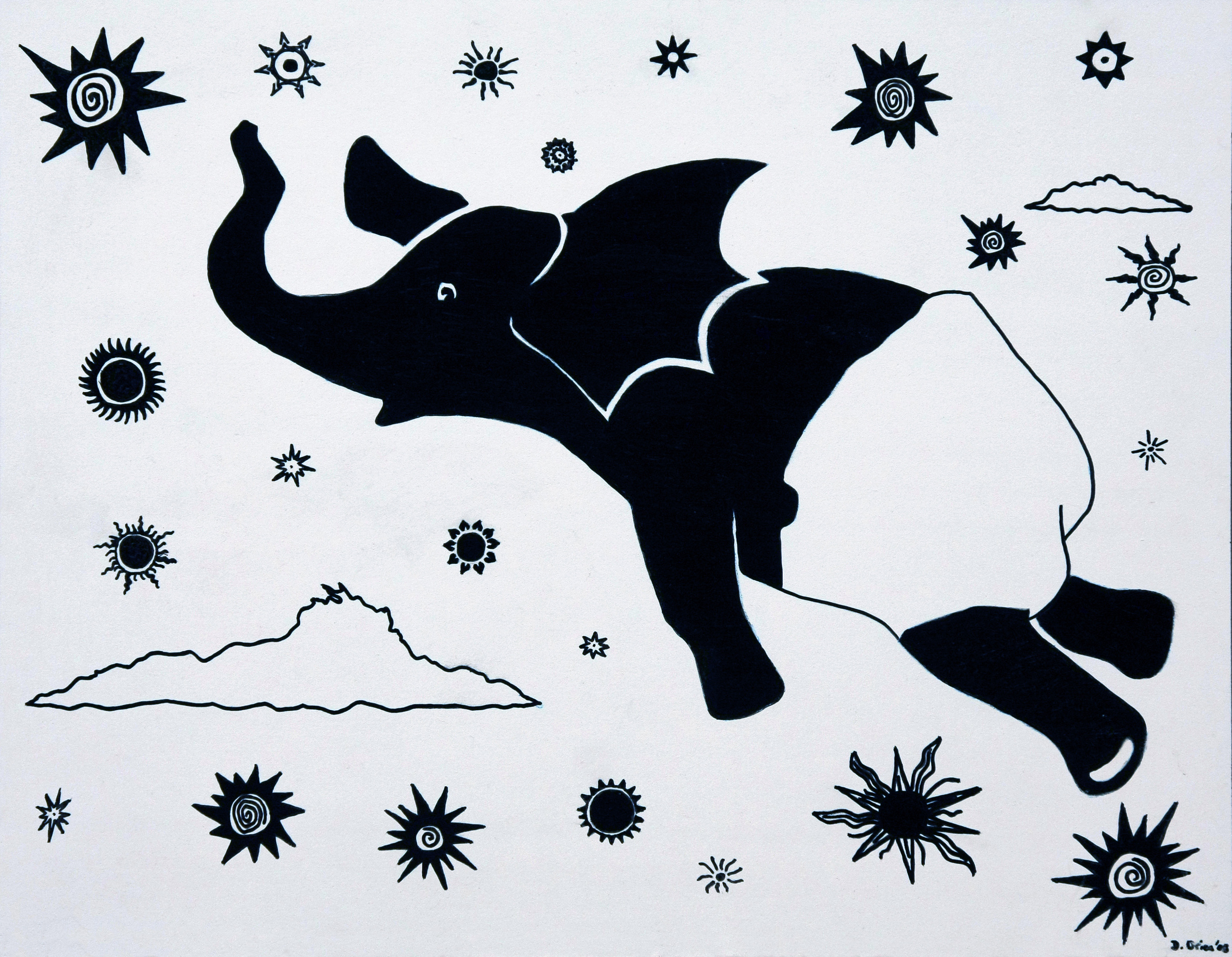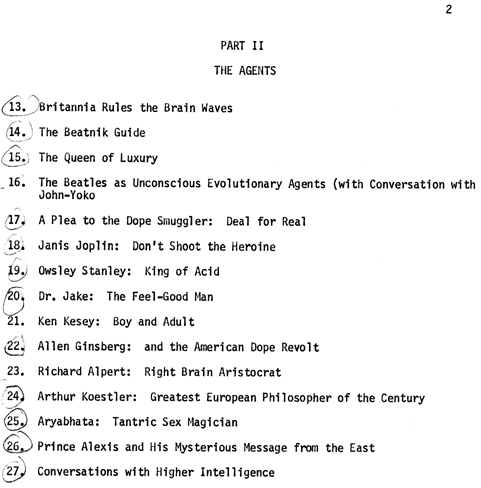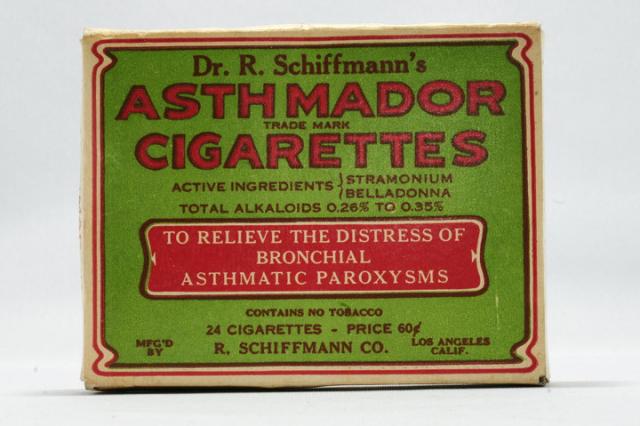My Life As An Ambien Zombie
One scribe’s misadventures with Ambien, the world’s freakiest sleep medication. Â
Drawings and paintings copyrighted Damon Orion, based on his Ambien Visions. Use prohibited without permission.
All my life. Right from the word go. For as long as I can remember, I’ve been doing exactly what I’m doing right now — lying on my back, staring into the darkness as my mind chases its tail, feeling like everyone in this time zone is asleep but me.
Ah, verily does it suck. Hour after hour, I fight the urge to look at the clock, knowing that it would only bring tidings of sorrow …
… until finally, sunlight rapes my eyeballs, and the birds begin celebrating my defeat with their taunting song of joy.
Yes, I was born this way: an insomniac, a sleep idiot, doomed to spend a quarter of my life praying for dreams that never come, and many, many of my remaining hours dragging my numb bones around in deflated, life-hating exhaustion.
Sleeping is one of the most basic things a living being can do. Even friggin’ turkeys have it down, and we’re talking about creatures that will flee in terror from a windblown scrap of paper here. How the hell can I be so bad at it?
Not long ago, I thought I’d found the solution. With the aid of Ambien, the world’s freakiest prescription sleep medication, I was able to temporarily bribe the Sandman … until the cure started looking worse than the problem. Here, if my sleep-needy memory serves, is how it all went down.
Sweet Dreams Are Made of This
My prescription for Ambien has come with a handful of warnings from my doctor: It can be addictive; it can lose effect over time; it’s recommended for short-term use only. I figure if it loses efficacy, I’ll be no worse off than when I started. What I’ve seen of drug addiction didn’t really look like a whole bucket of awesome, though, so as a safeguard, I’ve resolved to take Ambien only twice per week.
Somewhere around a half-hour after taking the drug for the first time, I learn something the doctor forgot to mention: This stuff is SpongeBob freaking SquarePants in a pill. As I lie there, skeptically waiting for sleep, an absurd, goofy-happy feeling seeps into me, and suddenly I want to put on a bunny costume and bounce around the house on a pogo stick.
The dopey feeling gets stronger … and without warning, I find myself experiencing the mind-blowingly bizarre reality of being wide-awake while, with shut eyes, I watch what I would be dreaming if I were asleep.
I’m not making this up: The face of Emmanuel Lewis, cuddly child star of the ’80s sitcom Webster, appears out of nowhere surrounded by several brightly colored concentric rings. Smiling, he pulls back a rubber band, using it to shoot a burning Satanic pentagram at me.
The pentagram expands several times in size as it travels toward me — by the time it reaches me, it’s larger than I am. There is no pain, only awe, as the flames envelop me, scorching my everyday consciousness and taking me fully into Ambien Land. All this happens within the space of a few seconds.
Now the flames melt away, giving way to an aerial view of an absolutely gigantic birthday cake. This thing is at least the size of a swimming pool, and it’s bubbling and warping like a slab of cheese on a hot stove burner.
And then … a miracle happens: I fall asleep. Just as the doctor told me I would, I sleep exactly six hours. Eight would’ve been better, but when you’ve got insomnia like mine, that’s like Danny DeVito complaining that he placed only fifth in People magazine’s 50 Most Beautiful People list.
Further Down the Rabbit Hole
Hoping that the birthday cake was some kind of symbol of a rebirth into a new life of well-rested bliss, I cheerfully take Ambien again the following night, curious to find out if last night’s loopy feeling and wacky visuals were some kind of fluke.
In wordless answer, The Cupcake People appear before my closed eyes. That probably needs some explanation: The Cupcake People are four living, breathing cupcakes—a mom, a dad and their two adorable cupcake children—who are riding a roller coaster together. With their pink frosting, strawberry mouths and bright, rosy smiles, they’re the very picture of wholesome family fun except for the fact that they’re … you know … human cupcakes.
Naturally, I begin to look forward to the two nights a week when more gloriously idiotic short films will be projected onto my inner eyelids as I wait to fall asleep on Ambien: a ram with horns made of candy cane; Gene Shalit grinning obnoxiously as a Frisbee spins on his upraised middle finger; a huge, stupid seaweed monster stumbling blindly through an airport wrecking everything in his path as a tiny human family tries to guide his way; the Trix rabbit using a giant tobacco pipe as a golf club; a view through the eyes of a spider that a Mexican family is trying to crush; a buffalo dressed up as a superhero, looking incredibly pissed off about the whole affair; a black elephant with bat wings for ears, wearing diapers as he flies through the clouds; a statue of Boba Fett in the pose of Rodin’s “The Thinker†and many, many others, some of them too complex to explain in words. There are even visual puns, like a hippopotamus/platypus hybrid that is obviously named a “hippoplatypus,†or a large door with two knockers—and a plaque above them that looks like a female face.
It doesn’t stop with visuals, though. On Ambien, your head becomes a late-night surrealist radio station, broadcasting little snippets of songs, quick phrases (“rent-a-rhinoâ€), poems (“And so I find the rodent signs that splitter-splat a kitty catâ€) and just plain whacked-out noises. One evening, I am treated to a piece of an epic Wagnerian opera in which a male tenor sternly commands his buddy to buy him a beer. In the disoriented state that the drug brings on, it’s hard to discern that these sounds aren’t coming from outside sources; at times I think I’m inside some kind of chat room where people communicate in song and poetry.
One night, for reasons unknown, the Ambien hits much faster than usual, and as I lie there reading, I can’t help noticing that the tapestry on my wall is breathing. Mind you, I’ve only taken the recommended dose of Ambien: one pill.
As I continue to study the tapestry, I notice the moving face of a dejected-looking monster in a spot on the lower right. He has the sullen, ashamed look of a child who’s just lost the game for his baseball team. My attempts to cheer him up by making funny faces at him don’t seem to help. At this point, it occurs to me that my sanity is riding a giant kite to the lollipop factory, and I should probably hit the hay before I start trying to stick my toes up my nostrils.
GABA? GABA?? Hey…
The following day, my tapestry is back to normal, but my doubts about Ambien’s safety are at an all-time high. Google reveals that “Ambien†is a brand name for a hypnotic called zolpidem, which is in the same chemical family as Valium and Xanax. It works by potentiating gamma-aminobutyric acid (GABA), an inhibitory neurotransmitter. (Rumor has it that the name Ambien is a cute way of saying “good morningâ€: a.m. bien.)
On the plus side, it seems that some recent medical reports have stated that zolpidem has been helpful in waking people in persistent vegetative state (PVS) as well as dramatically counteracting the effects of brain injuries. On the other hand, hallucinations (which, it turns out, are very common, and for some people, horrifying) aren’t the only weird side effects of the drug. Apparently it’s not unusual for people on Ambien to go on eating binges in their sleep. Raunchy junk food seems to be the snack of choice, but in extreme cases, Ambien takers have supposedly eaten stuff like buttered cigarettes, salt sandwiches and raw bacon. One woman recounts having gotten up at around 4 a.m. and fixed up a tempting mix of ranch dressing, milk, an entire tub of butter, some ham and cheese shreds and a full jar of mayonnaise. None of these people have any recollection of their eating binges the following day. An evil hypnotist couldn’t have devised a better prank … and again, Ambien is a hypnotic.
Mulling this over, it occurs to me that a number of my Ambien visions have involved food, some of it sugary (a skull with maraschino cherries sticking out of its eye sockets, a magic mushroom disguised as an ice cream cone, birthday cake, candy canes, cupcakes) and some not (a dragon made of lasagna, a dude with peas protruding from his flesh, a mask of the pagan icon The Green Man made of broccoli). Yeesh. How long till I wake up with a half-eaten shoelace quesadilla at my bedside?
More Internet entries tell of Ambien takers doing other unsafe and/or intensely weird stuff in their sleep: showering, having sex, making crazed phone calls in the middle of the night, walking almost nude into 20-degree weather, whizzing in public, whizzing into the oven, writing on apartment walls with nail polish, cutting themselves up, trying to jump out the window … one person claims to have been on Ambien when he tore off his shirt and threatened the passengers on a plane to England. Another says that the morning after taking Ambien, she woke up at the bottom of the stairs with head injuries that required 18 staples. Once again, none of these people have any recollection of their actions the following day.
Perhaps the scariest accounts, though, are those of people driving in their sleep on Ambien. As you can imagine, these tales don’t all end with “… and then the wise and compassionate Ambien Bumblebee appeared, using giant dandelions to point the beautiful dreamer to safety.†A driver on Ambien is considered to be many times more dangerous than a drunk driver, and after spending part of last night trying my damnedest to get a monster in my tapestry to look on the bright side of life, I’m gonna go ahead and give that assertion a double thumbs-up.
This is starting to look like grade-A horror movie material: Zolpidem Zombies terrorize the town, attacking bystanders, crashing cars, devouring pets, proposing to fire hydrants. And speaking of brain-eaters, what’s most troublesome is the thought that this stuff might be screwing with my brain chemistry… which, believe it, is not exactly a specimen of normalcy to begin with. It’s possible that all the images of brains that have shown up in my Ambien visions were distress signals, like when your car flashes an image of a battery to tell you that its battery is in trouble. (These images included a bald head with a tattoo of brains; the top of someone’s head opening like a lid, revealing a record being played on a turntable; a brain floating in the sky, letting out rain as if it were a storm cloud and, in a tidy union of the brain imagery and the candy motif, a brain made of swirling colors like the ones you’d find in a Gobstopper. One night I also saw a wicked-looking chef with a twisted green face stirring something very nasty in a pot, which, in retrospect, strikes me as dream language for, “Dude, this chemical: not good.â€)
Besides, as the doctor warned, the drug is getting less reliable. More and more, I find myself waking up after two or three hours, and sometimes the stuff doesn’t knock me out at all. Potential addiction + lack of dependability + fear of waking up with peanut butter stripes where my eyebrows used to be = so long, Zombien.
Last Dance with Zolpidem
My decision to stop taking Ambien just so happens to coincide with the fact that I’m down to my last pill. I won’t be getting a refill, but for the sake of journalistic intrepidness, I pop my final tablet and jot down a few notes before bed as the drug hits (spelling errors included):
My perception is off—the back of my hand looks like the front of my hand facing the wrong way. The tapestry on my wall seems to billow and breath. Clarity oth thought is still with mu … or so I thought until writing that. Previously flat objects appear 3D. There is a sense of soothing friendliness, as if honey is being poured through my nervous system. Colors are exaggerated and translucent. Utterly indescribable sounds pass through my mind—whisked by pharmaceutical winds, flypapers of melody flap through my brain, picking up bits of mental grunge and emotional residue. Safe, happy feeling of child at play. Thought becomes music. D’naoajamasjamas. Pattern in wood seem to rise up out of wood. Level of movement in tapestry is now absurd—it’s like boa constrictors are playind underneath. It is my psychotropic toy, the puppet of my altered brain. I know these snakelike downward melting motions aren’t really happening—but is this tapestry a mirror for what the drug is doing to my brain?
Setting down the notebook, I take a quick look at a drawing I’ve recently made of my very first Ambien vision: Emmanuel Lewis and the pentagram. Seen through Ambien goggles, Emmanuel’s face appears to be moving—it contorts and sneers in a way that can only be taken as sinister. I’m aware that it’s a hallucination, but the movement sure as hell looks real. I can honestly say I never thought I’d see Emmanuel Lewis looking threatening, but his hardened gangbanger snarl warns that anyone can be threatening on the wrong chemicals.
And all at once, this image, which I once savored as the ultimate in random, is revealed for what it truly is: an impressionist portrait of Ambien itself—a devil in the disguise of a goofy, harmless little buddy; Emmanuel, false savior of the restless, smiling gently as he burns his followers alive with hellish fire.
Many of the other Ambien visions that I’d thought were so deliciously meaningless are now unmasked as the Demon Zolpidem himself, shape-shifting into his manifold manifestations: a leering death-skull hiding behind maraschino-cherry-red eyes; a dangerous hallucinogen costumed in ice cream sweetness.
Where Gene Shalit fits into all this, I’m not sure yet.
After the Fire
Hey, I know better than to push my luck with Emmanuel Lewis.
It’s now been a few months since I last took Ambien. Sometimes I miss the way the stuff turned my head into a boatful of mutant minstrels, but you know what’s even more fun than that? Knowing that I won’t be waking up nude at the top of the clock tower wearing ketchup as makeup.
And so the search continues for an insomnia cure. I’ve just started taking Lunesta. It’s supposedly non-addictive, and it doesn’t have that whole Oompa-Loompas-from-Hell thing to it that Ambien does, though I’m told that horrible nightmares can be a danger. So far no problem there, but I did have a dream that as a reporter, I was trying to get some dirt on Britney Spears by tracking down one of her ex-boyfriends, which I suppose qualifies as a bad dream.
If this were a horror movie, this would be the part where the container of Lunesta on my desk starts to glow deep red, and suddenly I realize that I’m trapped in a dream. Smoke creeps out from under the lid of the container, through which throbs the fiery outline of a pentagram.
BOOM! The lid flies off, spraying flames, and with an abruptness that makes the whole audience jump, the towering specter of Emmanuel Lewis appears in the cloud of fog billowing from the container.
“You think you’ve escaped me, boy?†he bellows in a guttural, demonic voice. “Dream on, schmuck! The nightmare is just beginning!! Hahahahaaaaaaa!!!!â€
Roll the credits.
















